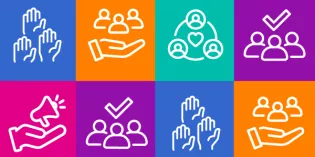Introduction
AIDS stands for “Acquired Immunodeficiency Syndrome”. It is caused by a virus called HIV, a virus that affects the immune system in humans. HIV stands for “Human Immunodeficiency Virus”.
Once it is in the body this virus attacks and destroys healthy cells that help the immune system.1 A person who has the HIV virus is said to be HIV positive.2
A person has AIDS when his or her immune system has been damaged so severely by HIV it can no longer ward off infections.3
As the disease progresses people get more and more opportunistic infections that their bodies would usually be able to fight off. Eventually people with AIDS die of 1 or more of their opportunistic infections.4
Extent
It is estimated that worldwide 42 million are living with HIV/AIDS. 14,000 people are newly infected with HIV every day. Approximately 3 million people died of AIDS related causes during 2002.5
The disease is particularly prevalent in Sub-Saharan Africa. In 2001 approximately 28.5 million were living with HIV/AIDS in this region.6
How is it spread?
The HIV virus is passed from person to person, when they share bodily fluids such as blood, semen, vaginal fluids or breast milk.7
Treatment
Today there is treatment available for people with HIV/AIDS in wealthy countries. However there is no cure or vaccine.8
History of the virus
HIV appeared in the early 1980s. In 1982 the Centre for Disease control and Prevention first used the term “Acquired Immunodeficiency Syndrome“. By 1986 the medical community decided upon the name HIV.9
Relevant records held at RCPCH
- HIV infection in Infancy and Childhood (1989)
Reference- RCPCH/011/003/032This is a BPA report that considers paediatric issues on HIV infection. - AIDS Syndrome in Childhood (1986)
Reference-RCPCH/011/003/029
A statement prepared on the behalf of the British Paediatric immunology and infectious diseases group - AIDS in Children (1987)
Reference-RCPCH/007/103Submission from the British Paediatric Association to the House of Commons Social Services Committee. It covers topics such as sources of infection of AIDS, surveillance of the disease and possible treatment. - Working party on AIDS in infancy and childhood (1985-1989)
Reference- RCPCH/003/050A file which contains documents relating to the working party on AIDS in infancy and childhood. These include correspondence, minutes of meeting and a draft report in relation to the working party. - HIV and AIDS (1988-1994)
Reference - RCPCH/007/357File of reports, policies and guidelines, newsletters, and correspondence relating to HIV and AIDS in the UK. - Reducing Mother to Child Transmission of HIV Infection in the United Kingdom: Executive Summary and Recommendations (1998)
Reference - RCPCH/011/003/184
Recommendations and Executive Summary of an intercollegiate working party for enhancing voluntary confidential HIV testing in pregnancy.
- 1Michelle. M Houle, Aids in the 21st century, What you should know (Berkeley Heights, NJ: Enslow publishers Inc, 2003), P. 9
- 2Michelle. M Houle, Aids in the 21st century, What you should know (Berkeley Heights, NJ: Enslow publishers Inc, 2003), P. 19
- 3Michelle. M Houle, Aids in the 21st century, What you should know (Berkeley Heights, NJ: Enslow publishers Inc, 2003), P. 9
- 4Michelle. M Houle, Aids in the 21st century, What you should know (Berkeley Heights, NJ: Enslow publishers Inc, 2003), P. 9
- 5Michelle. M Houle, Aids in the 21st century, What you should know (Berkeley Heights, NJ: Enslow publishers Inc, 2003), P. 10
- 6Joint United Nations Programme on HIV/Aids, Report on the global HIV/Aids epidemic (Geneva: UNAIDS, 2002), p. 22
- 7Michelle. M Houle, Aids in the 21st century, What you should know (Berkeley Heights, NJ: Enslow publishers Inc, 2003), P. 11
- 8Michelle. M Houle, Aids in the 21st century, What you should know (Berkeley Heights, NJ: Enslow publishers Inc, 2003), P. 32
- 9Michelle. M Houle, Aids in the 21st century, What you should know (Berkeley Heights, NJ: Enslow publishers Inc, 2003), P. 18










